OGD (The Road Song) and The Ghost of Sejanus
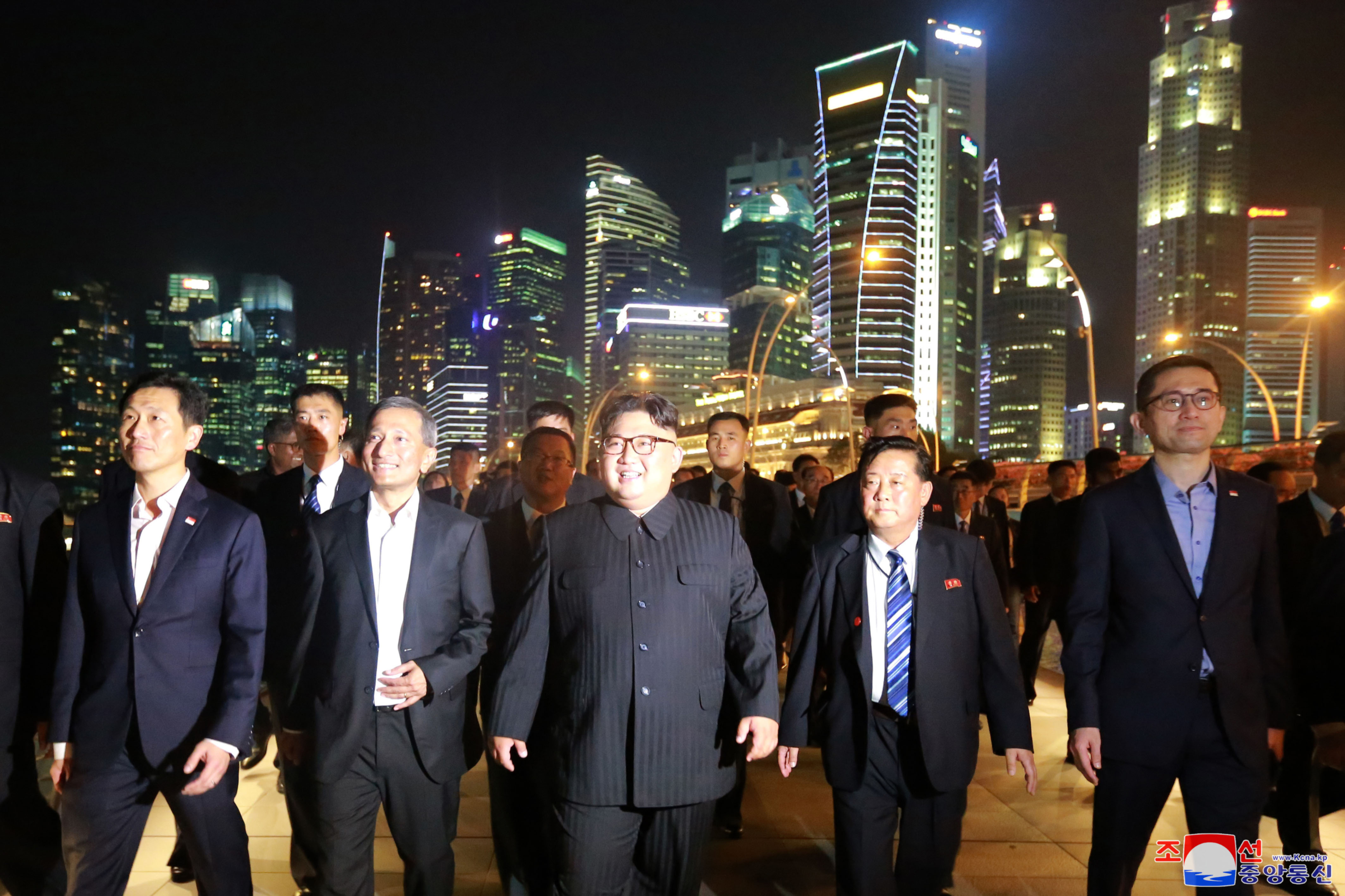
Kim Jong Un walks through Singapore during the evening of June 11, 2018. Also in attendance on the right of KJU is his lead bodyguard and the Director of the Main Office of Adjutants (Photo: KCNA/KNS).
Prior to Kim Jong Un’s (Kim Cho’ng-u’n) departure for Singapore some news appeared questioning things such as whether Jong Un venturing out for his high-level summit with US President Donald J Trump would be safe to his authority back in the DPRK, and a more complex reading of how the country monitors access and use of its nuclear weapons.
The former scenario–one in which Kim Jong Un would find himself neutralized, placed under house arrest (a rumor that used to appear about KJI) or facing a violent challenge to his power–is certainly a compelling trial balloon, but is not likely to happen. The DPRK’s internal security services (People’s Security, State Security and the Military Security Command [MSC]) are kept mutually in check by a variety of formal and informal reporting channels that run through the Workers’ Party of Korea (WPK) Organization Guidance Department (OGD) and Kim Jong Un’s Personal Secretariat.
The various security units that comprise Jong Un’s body guard–the Main Office of Adjutants, the Guard Command, the Pyongyang Defense Command and III Army Corps–report directly to him in his capacity as WPK Chairman and Korean People’s Army (KPA) Supreme Commander, despite the latter two being formally part of the KPA General Staff Department. Despite being a seemingly united front to protect the Suryo’ng who exercises unified command over his Praetorian Guard units, DPRK core leadership leave nothing to chance. As such, each of these institutions have carefully delineated missions and are required to “stay in their lanes.” At the top of this heap is the Main Office of Adjutants and the Guard Command, which have some overlap in terms of personnel recruitment and retention.
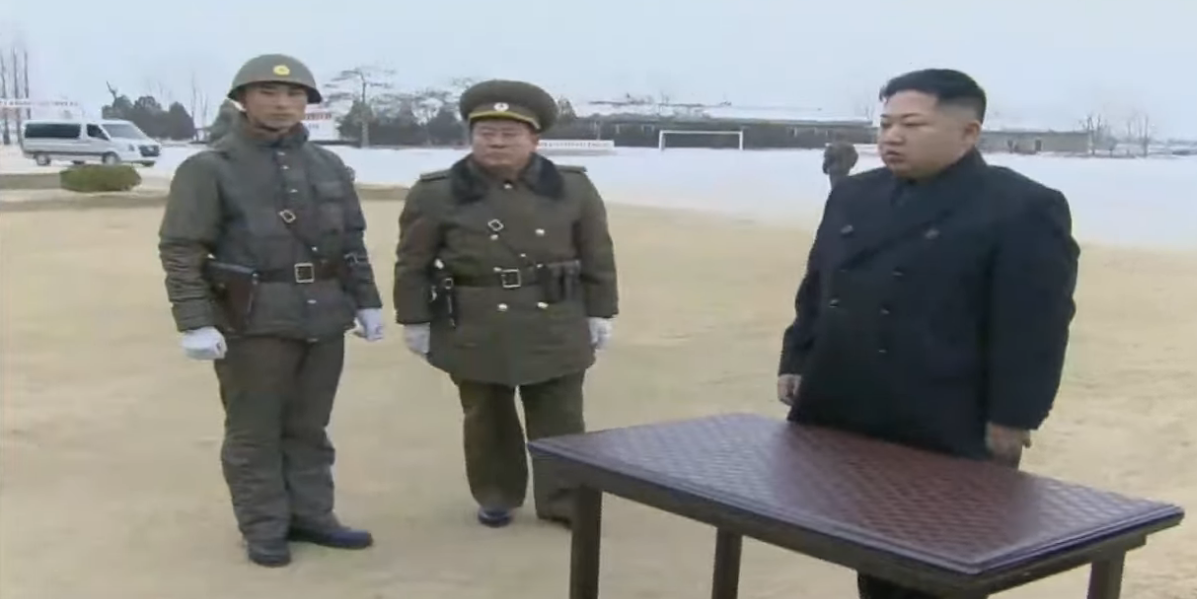
A member of Kim Jong Un’s close security escort and his head bodyguard and the director of the Main Office of Adjutant (left). In the background is a member of the Guard Command (NK Leadership Watch file photo/KCTV)
Main Office of Adjutants (MOA) The MOA forms the inner ring of Kim Jong Un’s close security escort (i.e. bodyguards). It left in place a skeleton crew during Jong Un’s Singapore sojourn, with protective details for his wife Ri Sol Ju (Ri So’l-chu) and their children, as well as his half-sister and close aide Kim Sul Song (Kim So’l-so’ng). Most of the (ca.) 200 guards were dispatched to Singapore to protect Jong Un, Kim Yo Jong and other top leaders.
Interestingly, the drama around protecting Kim Jong Un did not unfold back in Pyongyang. According to some most excellent sources, there was a minor commotion and some anxiety among MOA personnel when Jong Un went on his evening walking tour around Singapore. This has not affected the career of the MOA director and his lead bodyguards, who have all be observed on his third visit to China during June 19-20.
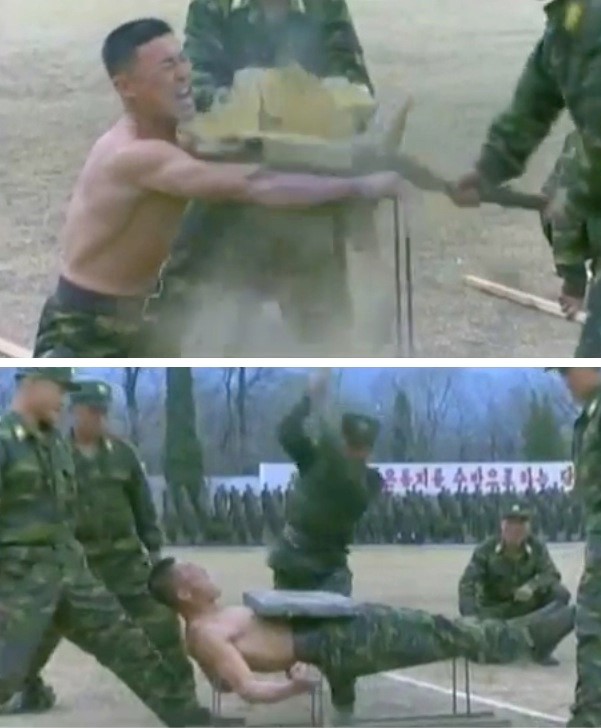
These images show an exercise by a KPA special operations forces unit in 2012. Guard personnel of the Main Office of Adjutants and the Guard Command undergo similar physical conditioning and endurance challenges (Photo: NK Leadership Watch file photo)
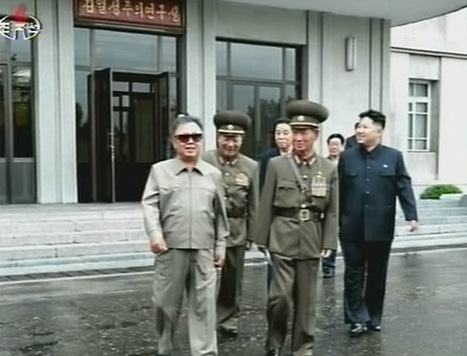
Kim Jong Il and Kim Jong Un inspect KPA Unit #963 the command element of the GC. Also in attendance are the GC’s Director Gen. Yun Jong Rin (foreground, 3rd left), the GC’s Political Director Col. Gen. Kim Song Dok (background 2nd left) and then-OGD deputy directors Kim Kyong Ok and Hwang Pyong So
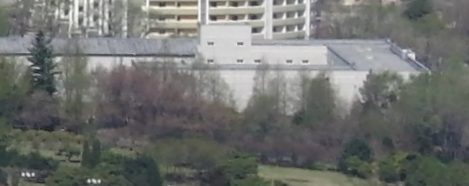
A component unit of the Guard Command on the northern perimeter of the Central Party Complex in Pyongyang (NK Leadership Watch)
Guard Command (GC) The GC plays a critical role when Kim Jong Un is both home and abroad. The GC’s primary mission to protect and observe the locations where the Suryo’ng works, lives, rests and visits. The GC also constructs, maintains and guards the infrastructure that he uses. It fulfills a number of other logistical, engineering and personal support missions for Kim Jong Un. The GC also supplies guards and chauffeur personnel for senior DPRK leaders (such as Choe Ryong Hae, Pak Pong Ju and the leadership of the KPA General Political Bureau) and members of the Kim Family.
It is routine that when the Suryo’ng is traveling outside the DPRK, particularly in the days or hours before his whereabouts are publicized in DPRK state media, the GC mobilizes the same number of personnel around the perimeter, and beneath (in sub-basements and tunnels), the WPK Central Committee Office Complex (where Jong Un’s headquarters and official residence are located) as if he were working in his office. This applied to late leader Kim Jong Il’s excursions to China and Russia, as well as to Kim Jong Un’s trips to China and Singapore. GC guards are used as much as a durable protective force, as well as to send a message to malcontents within the regime not to have any creative ideas.
GC divisions and brigades stationed at VIP locales in other parts of the DPRK (Samjiyo’n, Wo’nsan, Yo’np’ung, etc) will also expand their perimeters. When Kim Jong Un used the train on his first visit to China, GC battalions established footprints near and within the vicinity of the towns that line the DPRK’s northwest railway corridor.
In addition to its guards, escorts and equipment, the GC also consolidates and analyzes surveillance reports collected by the internal security services, the KPA General Political Bureau and the OGD. It also links with the Ministry of People’s Security to conduct sporadic eavesdropping on the telecoms within Pyongyang and telecoms lines between provincial cities and Pyongyang.
The Guard Command has about 100,000 personnel broken down into several divisions, battalions and companies. These include guard, escorts, tank units, anti-aircraft artillery, elite construction units, drivers and logistics and rear service personnel. The GC also has specialized WMD/ballistic missile companies and probably links directly with the KPA Strategic Force.
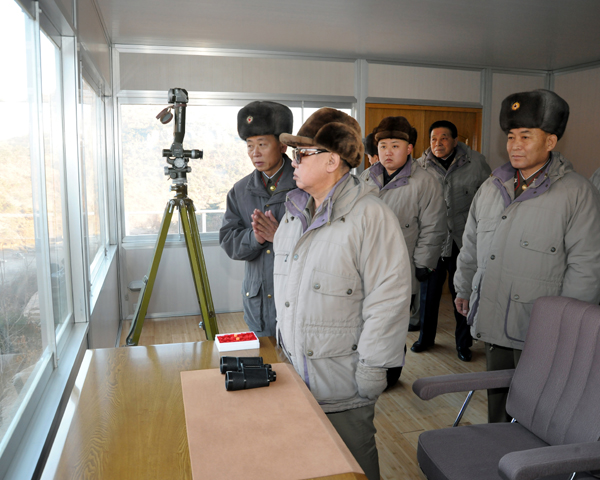
Kim Jong Il and Kim Jong Un observe live fire exercises of an artillery unit of the Pyongyang Defense Command in December 2011 (Photo: KCNA).
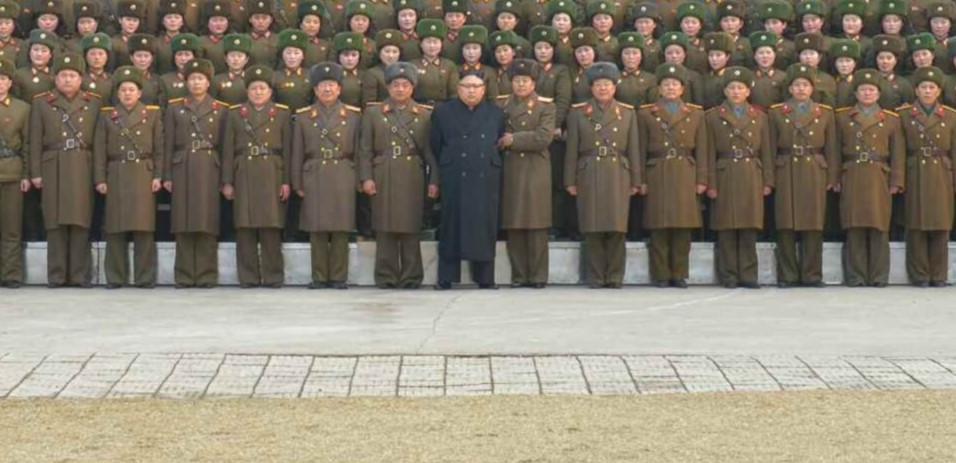
Kim Jong Un poses with the command staff and political officers of the Pyongyang Defense Command in March 2017 (Photo: NK Leadership Watch file photo/Rodong Sinmun).
Pyongyang Defense Command (PDC) Also known as the 91st Metropolitan Defense Corps, the PDC is responsible for the military defense of Pyongyang and its immediate vicinity. It has an estimated 70,000 personnel; about 50,000 personnel serve as guards (infantry and light infantry) in approximately 12 brigades and about 20,000 are in anti-aircraft, artillery and tank units. The PDC is primarily deployed south and west of Pyongyang.
In the past, the PDC has been directly subordinate to the GC. During the later years of KJI’s rule and for all of Jong Un’s leadership, the PDC has been a stand alone unit formally subordinate to the KPA General Staff Department (GSD). Training and planning is conducted by the GSD Operations Bureau and its command staff report directly to Kim Jong Un. The PDC’s command element and largest unit is KPA Large Combined Unit #966, with the command staff based in facilities in east Pyongyang.
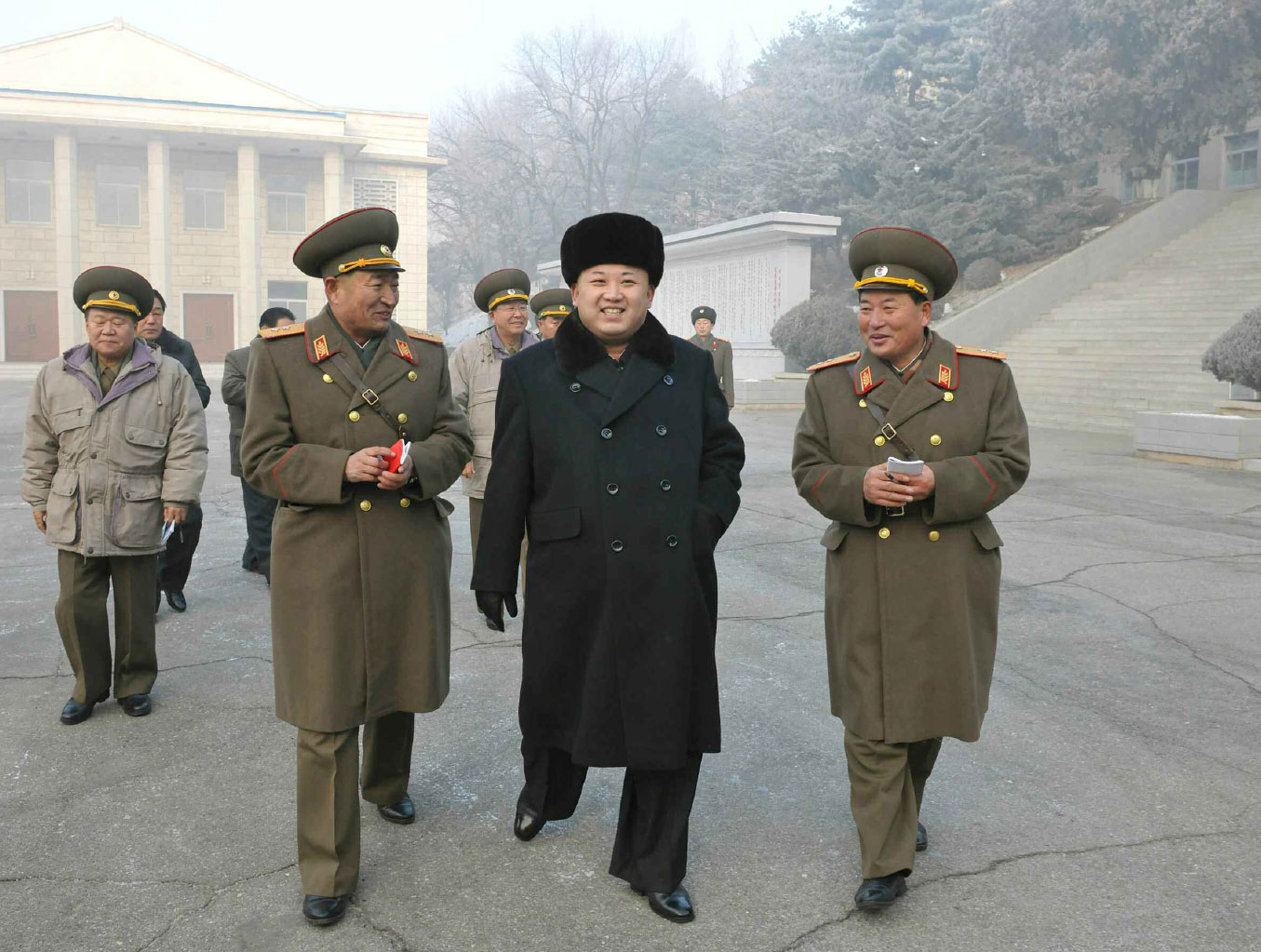
Kim Jong Un inspects the command element of KPA Large Combined Unit #526, which is part of the III Army Corps (Photo: Rodong Sinmun)
III Army Corps The III Corps is one of the KPA’s ground corps units which forms the outer defense line protecting Pyongyang. It is formally subordinate to the KPA GSD and links with the PDC and GC. It has an estimated 45,000 personnel with its brigades and battalions stationed on the outskirts of Pyongyang, North Hwanghae Province and north of Namp’o.
South and west of Pyongyang, III Army Corps units mix with PDC units based on location. However, there does not appear to be any horizontal communications channels between these units (i.e. PDC units do not communicate with III Army Corps units). Instead communications and coordination are vertical (up the chain of command to the Supreme Command) with orders and guidance passed down.
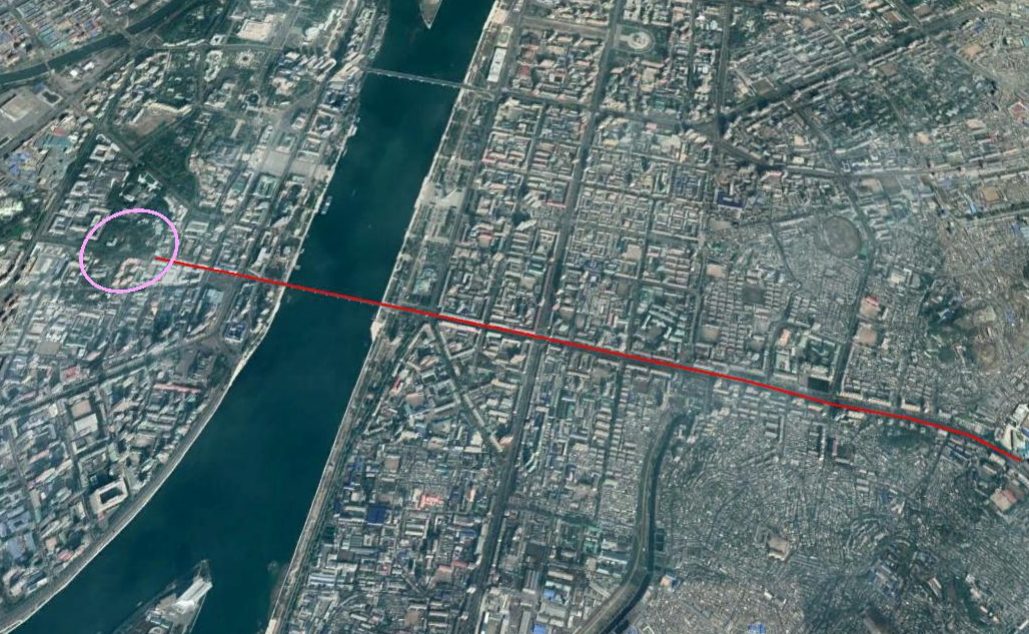
This is a limited view of GC and PDC positions. The pink circle shows the view of a GC component unit south of KJU’s headquarters. The red line indicates the distance between that GC component unit and the nearest PDC unit (Photo: Google image).
A Quick and Dirty Guide to the Praetorian Guard’s Posture and Interactions
The rough estimate of personnel which constitutes the Praetorian Guard is between 250,000 to 300,000. This includes the above-mentioned organizations (MOA, GC, PDC and III Army Corps) along with elite units of the reserve military training units (RMTUs). In Pyongyang and its general vicinity–that is to say an area between P’yo’ngso’ng, Namp’o and Sariwo’n are between 125,000 to 150,000 personnel whose mission is the protection of Kim Jong Un and the DPRK’s core leadership. There are some key things to know about how these units and personnel are deployed and how they interact.
- Units of the GC and PDC break down into smaller bases (brigade or battalion) which are largely organized based on their mission (i.e. guard/escort, artillery, mechanized) and the technical support required
- These GC and PDC bases are generally self-contained and include relevant headquarters and rear service elements; III Army Corps, by contrast, is largely organized like other KPA Corps units in which headquarters and rear service elements are dispersed
- GC brigades and battalions are primarily located in and around Pyongyang’s city center and whatever the GC identifies as a strategic location (such as Mansudae Assembly Hall, Ku’msusan Palace of the Sun, near the KPA Supreme Command and #55 Residential Compound)
- GC units try to establish a 360 degree protective line around a given location
- In terms of deployment, GC units will be mixed with PDC units, and PDC units will be mixed with III Army Corps units. Thus, it is impossible for would-be domestic challengers in the military or internal security services, or outside observers, to precisely identify what brigades, battalions or even companies belong to which constituent of the Praetorian Guard
- The GC’s Rapid Response Battalion and other GC mechanized units, in the event of an attack or contingency, deploy along the main roads within Pyongyang and leading to the capital city to neutralize an attack and cut off access
- The PDC is kept at some remove from Pyongyang’s city center and from VIP residential compounds; the closest distance the PDC has to Kim Jong Un’s headquarters is three miles.
- The GC forms a protective line around Jong Un’s headquarters and residences in Pyongyang. In the event the PDC tried to attack one of these places, the GC deploys MLRS, tanks and mechanized forces to neutralize the PDC units. This has been observed on several occasions, likely simulations, in which GC mechanized forces deployed from concealed and/or underground positions to close proximity to PDC units
- The rough ranges of distance from Pyongyang’s city center to PDC units is 3-10 miles (4.8-16 km), for III Army Corps the distance is about 20-35 miles (32-56 km)
These layers of security were active when Kim Jong Un has gone overseas, as a matter of precaution. When he made his first visit to China some months back, these various organizations established a presence and deployed with a higher urgency than if Jong Un were in the Central Party Complex or tooling around the factories of the P’yo’ngch’o’n District. He and the core leadership expressed a high degree of confidence during his visit to Singapore and his recent visit to PRC by, more or less, reporting his whereabouts as they happened.
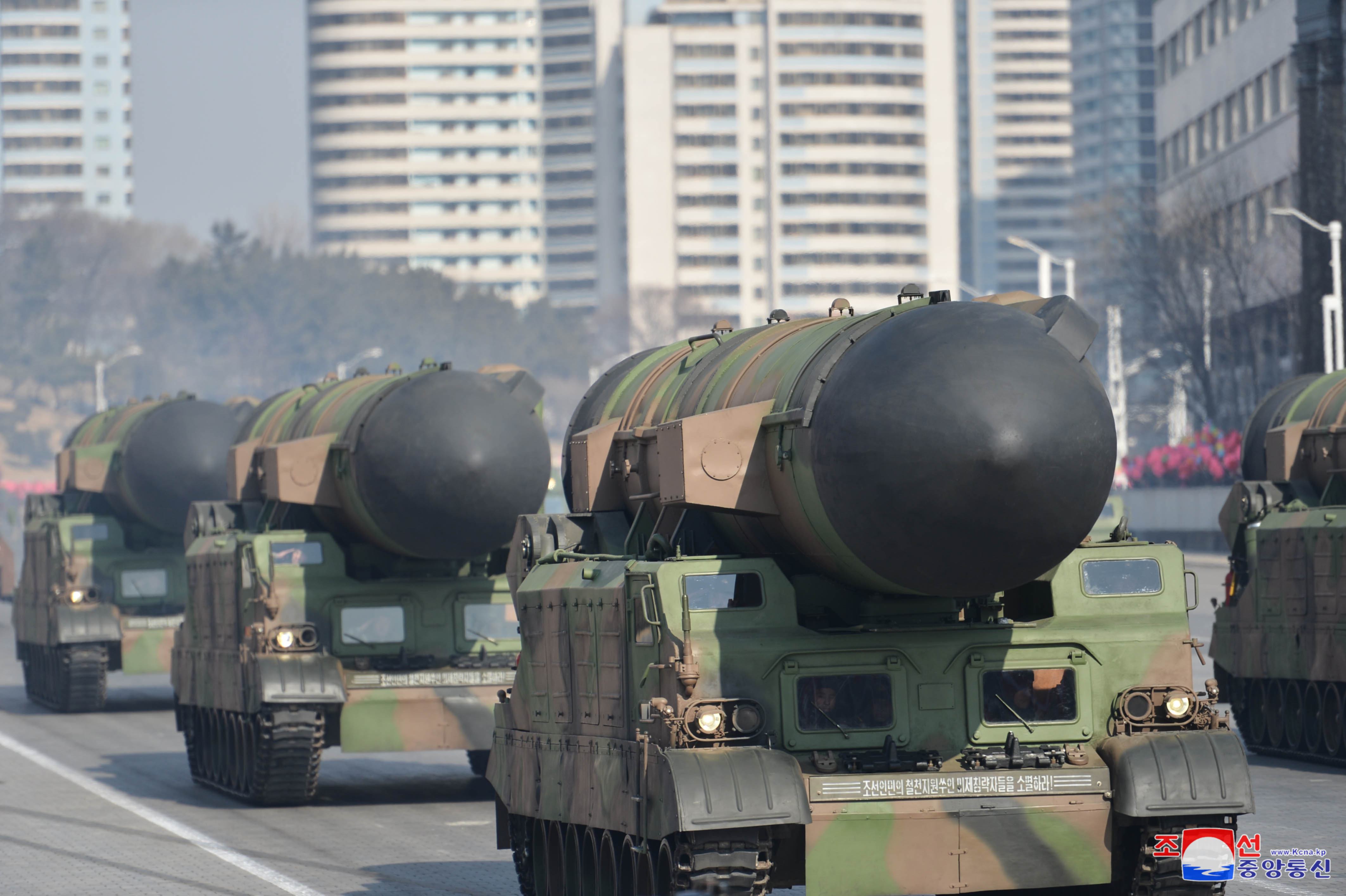
A Brief Word About How the DPRK Secures and Monitors its WMDs
A more relevant question that has arisen around Kim Jong Un’s foreign excursions is how the DPRK monitors access to its WMD and ballistic missile inventories, particularly as the country has achieved a credible mobile nuclear missile capability. As with the protection of the core leadership, the DPRK has multiple layers of surveillance and security around its WMDs , whether astride TELs or launched from stationary bases, and the C2 facilities and telecoms infrastructure from which a strike could be launched.
- access to launch capabilities is heavily restricted; when Kim Jong Un is at home then he can avail himself of on-the-fly command and control to order a deployment or even a strike with telecoms coordinated and provided by the GC and the Personal Secretariat
- when he is out of the DPRK, command and control of all DPRK military assets is coordinated out of the KPA Supreme Command headquarters in Pyongyang, part of which located under a mountain UGF, and links with the KPA Strategic Force command element which is also situated in a UGF
- given prior practices in the DPRK’s military industrial and research complexes, mobile ballistic missiles and artillery rockets are located in “closed” counties or “closed” administrative districts: the KPA Strategic Force and Second Economy Commission (Second Economic Committee) are located in an area of Kangdong County, Pyongyang, and So’ngch’o’n County, South P’yo’ngan, where access is restricted to all but top leadership; the Sanum-dong research campus in northern Pyongyang is located near intelligence training schools and the Kim Family’s Residence #55 compound
- personnel involved in the use, research or manufacturing of WMDs are under intensive surveillance and scrutiny by OGD
- even if OGD’s overt surveillance and social controls (via basic party organizations and embedded guidance cadres) fail, there are other personnel who report to OGD’s Notification Section, a separate back channel through which things like the behavior and activity of managers, industrial accidents and resource allocation are reported directly to OGD
- the State Security Department (SSD) maintains a Defense Industry Security Section which uses a combination of electronic surveillance and human intelligence networks to monitor the activities of managers, party functionaries, technicians, scientists and manufacturing personnel
- part of the DPRK’s drive in the last few years to attain a credible nuclear ballistic missile also involved the expansion of the personnel and authority of the MSC (Military Security Command)
- the MSC most likely has established a subordinate department or section devoted to continuous active surveillance of military and civilian personnel involved in the deployment, research and production of the country’s WMDs
Departures and Arrivals
There was a significant disparity in the number of senior DPRK officials who saw Kim Jong Un and his travel party depart for Singapore and the number of senior officials that greeted his return. Missing from the departure ceremony were the head of the SSD, the WPK Vice Chairman and Director of the Munitions Industry Department and the close aides to whom Jong Un entrusted temporary custody of the regime’s nodes of control. One might think that when the Suryo’ng departed, that these senior officials had more pressing things occupying their time, but they showed up when Kim Jong Un returned. Five officials to note at the return ceremony were:
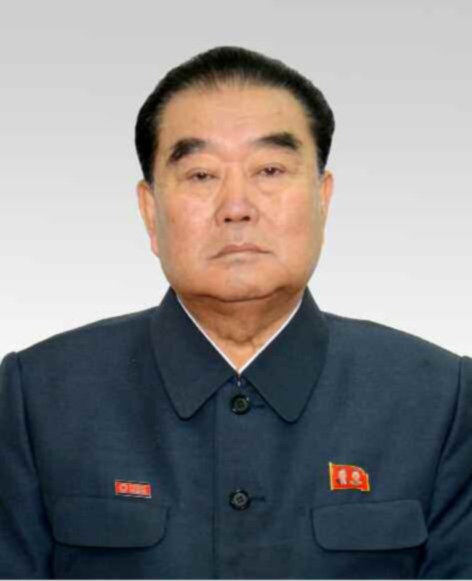
Thae Jong Su (T’ae Cho’ng-su) Thae is the WPK Vice Chairman and Director of the WPK Munitions Industry Department to which the Nuclear Weapons Institute, the Second Economy Commission and the Second Academy of Natural Sciences are all subordinate. While Kim Jong Un was in Singapore, Thae was responsible for the daily operational management of the research and manufacturing sites that contribute to the DPRK’s strategic and conventional weapons. He also processed routine situational reports about any R&D and manufacturing activities, as well as the security of relevant sites.
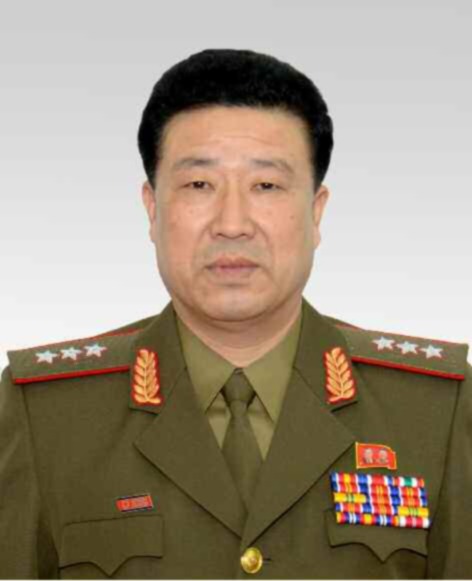
Col. Gen. Jong Kyong Thaek (Cho’ng Kyo’ng-t’aek) Jong is the Director of SSD (also known as the Ministry of State Security). During Jong Un’s absence he supervised the collection, consolidation and analysis of myriad intelligence reports from around the DPRK derived from eavesdropping and SSD’s pyramid-like human intelligence networks. Col. Gen. Jong probably supervised the mobilization of additional electronic capabilities and personnel to monitor the DPRK’s defense industry.

Ri Man Gon with Kim Yo Jong
Ri Man Gon (Ri Man-ko’n) Ri headed the Munitions Industry Department until he was replaced by Thae Jong Su in October 2017. He is currently one of the Senior Deputy Directors of OGD and it appears he may have assumed the portfolio previously held by Kim Kyong Ok, who is now semi-retired. This involves collecting numerous surveillance reports from across the DPRK’s internal security services, as well as supervising the above-mentioned Pratorian Guard organizations, including the GC, and the GPB Given Ri’s prior position as head of MID, it is highly probable that his writ extends to the surveillance and security of the DPRK’s WMDs via the MSC.
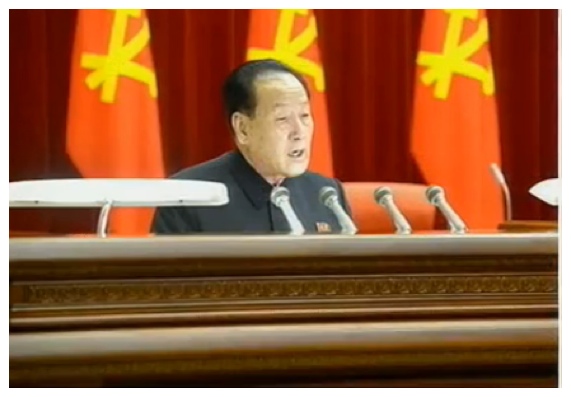
Jo Yon Jun (Cho Yo’n-ch’un) Jo is concurrently Chairman of the WPK Inspection (Control) Commission and the OGD Senior Deputy Director for Administrative Affairs. This finds him linking with SSD and the Ministry of People’s Security, as well as the OGD’s Notification Section and supervising the daily operations of the Central Party Complex. Jo’s focus is more on civilian officials in the party and government apparatus. This man has the metaphorical taxidermy of numerous, fallen DPRK leadership figures in his trophy room.
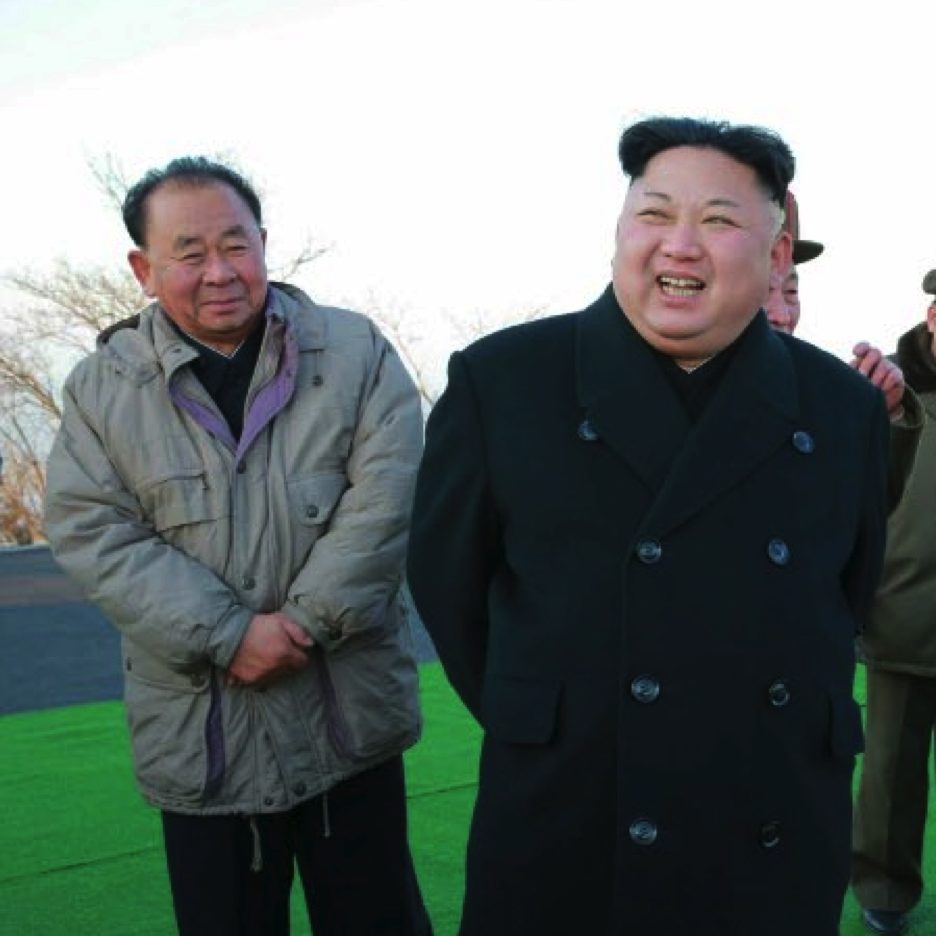
Ri Pyong Chol (Ri Pyo’ng-ch’o’l) To paraphrase Vanessa William, we’ve gone and saved the best for last. Ri, whom Jong Un has been previously observed hugging and who is a beloved elder relative of Ri Sol Ju’s, is probably the most important figure who stays in Pyongyang when the Suryo’ng leaves the country. Ri is a member, if not the head, of the Operations Command Group in the Personal Secretariat. The group, which has other interesting and notorious members, is a permanent VIP (sangmujo) group which was responsible for policy formulation, guidance and management of the DPRK’s engine tests, nuclear detonations and ballistic missile drills during the last few years.
But the group’s writ goes well beyond that. Ri Pyong Chol was most likely sitting in the KPA Supreme Command headquarters or in Kim Jong Un’s office on the Singapore visit and the third visit to China (Kim Yo Jong also stayed behind during that latter trip).